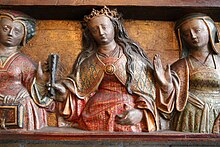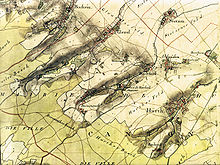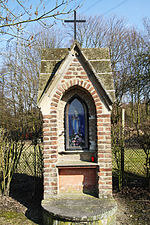Marienborn Abbey (Hürth-Burbach)
The land of the former Cistercian convent Marienborn (ad fontem sanctae Mariae) near today's Alstädten-Burbach not far from Lake Otto Maigler was donated by Guderadis, the wealthy widow of the Cologne patrician Hartmann von Geyr, in 1233. In 1236 the convent of the new Marienborn monastery was founded there.
founding
Around 1236, around half of the conventual women of the “overcrowded” convent, 31 women, moved from the Mariengarten monastery in Cologne to the new foundation. At the same time Marienborn received half of its goods. Then there were the Guderadis foundations. Mariengarten did not function as a mother monastery, but both monasteries were equally under the supervision of Kamp monastery . Nevertheless, there was often an exchange of nuns and abbesses between the monasteries.
Marienborn Abbey has had a technically well-developed water supply system since the late Middle Ages. The headwaters of the Burbach in the former marshland were captured, thus creating the basis for irrigation and energy generation. The traces of this "water art", an eloquent testimony to the monastic water supply, can only be found on old maps today, as the original terrain has changed significantly as a result of the industrial interventions in nature (→ brown coal in Hürth ). At the monastery there was a water reservoir, a grain mill and an oil mill, as well as the usual agriculture and livestock farming. A grain mill had existed since ancient times , half of which belonged to the St. Mechtern Monastery (today Cologne-Ehrenfeld ). This gave its share to the new monastery in 1238.
This enabled the Cistercian women to produce everything they needed for their basic needs and to lead a life without worldly interference.
Over the years various large donations and contributions from farms, land, pensions and natural products followed. Marienborn Abbey became the richest landowner in the area for centuries until it was abolished in the period of secularization .
Charter caritatis
In addition to the in regular cycle taking place visitations certain statutes of the Cistercians (the Charter of Charity ), the spiritual care of a wife Convention (Konventualinnen) by the abbot to exercise a nearby monk monastery (pater or Weisungsabt) the monastery leadership because it does not allow women in the Catholic Church is to exercise spiritual functions. According to the resolutions of the General Chapter of the Order , the duties of the Father Abbot also included annual reviews, as well as leading the election of abbesses or appointing confessors . Accountability also had to be given with regard to economic management. For Marienborn this was done by the Kamp monastery.
Time of the Counter Reformation
As a result and as a teaching of the Council of Trent in 1542-63, the Catholic Church tried to find answers to the Reformation . The level of education and the reputation of the clergy should be raised again through appropriate measures such as comprehensive visitations to church institutions.
The guided tours of the convent were audited , the nuns were checked for piety and religiosity , lifestyle (jewelry, secular clothing) and fulfillment of duties.
It is said that in 1569, at the insistence of the Pope, more control measures were introduced in the Archbishopric of Cologne under the Cologne Prince-Bishop Salentin von Isenburg (1567–77). A commission, which consisted of the Cologne auxiliary bishop , church councils and members of the cathedral chapter , also visited the Cistercian convents of Benden in Brühl-Heide (June 17, 1569) and Marienborn, Burbach, (August 9, 1569).
Possessions
In 1763, under the aegis of the abbess Anna Gertrud Dautzenberg, according to the monastery ledger, large estates with more than 1,400 acres of land were recorded as the property of the order.
Properties are named, including lands around the monastery to Berrenrath with 434 acres, 3 quarters of Busch above Berrenraths with 149 acres, the Stumbshof zu Berrenrath with 245 acres, a farm in Berzdorf with 316 acres, a farm in Brühl, called Burbacherhof, with 72 acres, the Kirch-Hof zu Frechen with 63 acres, lands in Königsdorf with 26 acres, lands in Erp with 23 acres, lands in the Hürth estate with 36 acres and on the Hürther Heide with 17 acres, plus 10 acres in Gymnich , the so-called Burbacher Güter zu Kessenich with 6 acres, Güter zu Bornheim with one acre and Güter zu Brenich with 20 acres, etc. Particularly important was the cloister courtyard in Cologne, the small Ringenphuhl near St. Mauritius, also called Burbacher Hof, the Abbey was mainly used to market its surpluses and to purchase other necessary things in the most important trading metropolis, Cologne. All regional monasteries had such courts there.
According to today's dimensions, the property covered around 3.5 km². The courtyard buildings of the former cloister mill listed in the register, which are still preserved today, belonged to the economic operation of the monastery itself. For this reason, they were free of treasure and taxes.
secularization
Around 200 years ago, secularization also changed the German west. After the Napoleonic Wars , the buildings, lands and property of the monasteries and dioceses passed into state ownership. The effects of these measures continue to this day. If the mostly empty buildings could not be put to new economic use, they were usually demolished. Marienborn Monastery was also affected by the abolition of religious institutions and the takeover of church property.
reconstruction
Due to special procedures (geophysical measurements of soil compaction), the monastery was roughly reconstructed. The position of the foundations of the monastic cloister was located . Next to this was the abbess house with external dimensions of 40 × 45 m. To the south of it stood the monastery church. The inner courtyard of the facility measured approx. 21 × 25 m.
On the basis of old maps, the ground plans made visible again , comparative studies of other Cistercian monasteries and the evaluation of a description of the monastery premises in a preserved auction report from 1809, the architect Fritz Bendler from Gleuel developed a reconstruction of the monastery complex.
Only a part of the monastery buildings remained as the substructure of the abbess house, which later became the forester's house. The year 1789 in the archway and a stone coat of arms with the year 1729 above the front door, nothing more was preserved in the building fabric. A baroque triumphal cross group from the former monastery church stands today in the parish church of St. Katharina in Alt-Hürth .
The last abbess of the monastery mentioned in a document was Bernadine Kesselkaul. The deed concerns the last monastic lease of the monastery mill in 1794.
Todays situation
The last tenants of the farm and mill (one of the former 16 mills in the Hürth area ), the Füngeling and Anna Gertrud Simon, erected a picture cane with a statue of the Mother of God where the church stood .
The picture stick bears the inscription:
Deo: This is where the [incorrectly assigned] Benedictine monastery stood. In its memory, this monument was erected by the married couple W. Füngeling and A. Simon MD CCC L II
Due to its dilapidation, the abbess's or forester's house could only be used temporarily for years. In 1990 it was extensively renovated.
Literature / sources
- Own research - Rosellen: From the main book of the Burbach monastery from 1753 - City Hürth archive
- Clemens Klug: Hürth - How it was, how it was Steimel Verlag, Cologne undated (1961)
- Hermann-Josef Hüsgen: Cistercian Sisters in Cologne. The monasteries Mariengarten, Seyne and St. Mechtern / St. Apern , Bonn Contribution to the Church History. 19, Cologne / Weimar / Vienna 1993.
- Hermann-Josef Hüsgen: The Cistercian monastery Burbach , in Erftkreis (ed.): Monasteries and monasteries in the Erftkreis , Pulheim 1988, p. 151–176
- Hermann-Josef Hüsgen: The necrology of the Marienbronn monastery. In: Awakening in the Memory of the Church, Studies on the History of Christianity in Central and Eastern Europe. Edited by Gabriel Adriányi, Reimund Haas, Karl Josef Rivinius, Hermann-Josef Scheidgen . Verlag Böhlau, Cologne 2000, p. 153. on Google Books
- Manfred Faust: For the virtual restoration of the Burbach monastery and
- Eric Barthelemy: Burbach Abbey - An auction expertise from September 5, 1809 and
- Fritz Bendler / Rainer Draaf: To attempt a reconstruction of the Burbach Monastery in an architect's plan and
- Hermann Plog: Sacred art from the historic Burbach Monastery Each in: Hürther Heimat , vol. 81 (2002) from p. 27 to p. 51
- Manfred Germund: The Burbach monastery in the tradition of the medieval monastery foundations of the Cistercian order and
- Rainer Draaf: The historical water mills of the Cistercian convent Burbach , each in: Hürther Heimat , vol. 84 (2005), pp. 9-17 u. 17-35
- A. Franzen (ed.): The visitation protocols of the first post-Tridentine visitation in the archbishopric of Cologne under Salentin von Isenburg in 1569 . Bonn 1960.
- Paul Clemen: On behalf of the Provincial Association of the Rhine Province Die Kunstdenkmäler der Rheinprovinz, in: Die Kunstdenkmäler der Stadt und der Landkreis Bonn , Volume V, III. Druck und Verlag L. Schwann, Düsseldorf 1905, reprint 1981. ISBN 3-590-32113- X
Individual evidence
- ^ Paul Clemen: Die Kunstdenkmäler der Rheinprovinz, in: Die Kunstdenkmäler der Stadt und des Landkreis Bonn , p. 15 f
- ^ Hüsgen: Nekrolog
- ^ Robert Wilhelm Rosellen: History of the parishes of the deanery Brühl , Cologne 1887, p. 67 (quoted in Draaf: Wassermühlen )
Web links
Coordinates: 50 ° 52 ′ 31.1 " N , 6 ° 50 ′ 25.3" E







